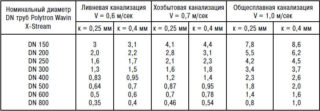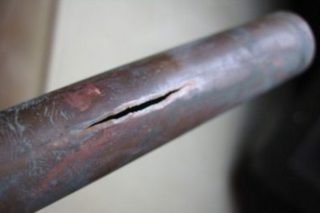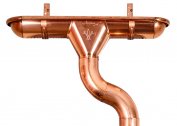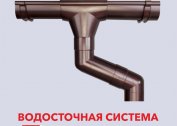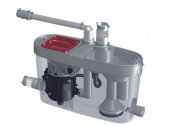Building codes and regulations (SNiP) during the installation of the sewer oblige to take into account the angle of inclination of the pipes with respect to the cesspool or septic tank. The overall system performance depends on how optimal the angle is. Too large a slope of the pipe and a high speed of water prevents the solid debris from being washed out completely, and the absence of an angle of inclination is a gross violation of building rules, after which solid particles begin to gradually accumulate on the walls and clog the pipe lumen.
What is the angle of inclination of the pipeline
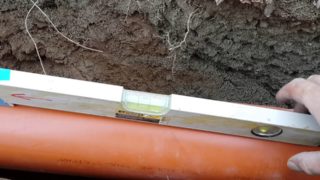
Installation of autonomous sewage begins with preliminary calculations of the length of the highway, the diameter of the pipes and their slope. The speed of the flow of water inside and the direction of movement will depend on this. It is especially important to follow the rules if sewage is planned gravity. Gravitational forces will direct sewage in a natural way to their place of storage.
The angle of the sewer pipe in a private house depends on such indicators:
- Pipe diameter. The larger it is, the smaller the slope.
- The material from which the pipes are made. A smooth inner surface facilitates the rapid passage of water and debris through sewers. Cast iron, asbestos cement and some types of synthetic materials have a rough surface on which a large layer of sludge adheres over time. This reduces pipe performance. Even with a large diameter, the throughput is reduced, and flooding occurs in the house if measures for cleaning are not taken in time. You will have to clean a clogged pipe regularly, and this is the inconvenience, the cost of chemicals and the call of a plumber.
- The layout of the sewer pipe system in the house. A smaller diameter for drains in the bathroom, shower and kitchen suggests a larger slope of the pipe.
In addition to the angle of inclination for the correct operation of the drainage system, it is important that there are no sharp and right angles in the connection of the pipe parts and in turns.
If the rules are not followed, the following problems are possible:
- siltation of the pipe and the cessation of the sewage system, which entails an increase in the water level in the toilet bowl, sink and the occurrence of problematic drainage in the bathroom;
- the appearance of an unpleasant smell in the apartment due to the poor operation of siphons;
- pipe break and basement flooding.
Both minimum and maximum slopes are important. Extremes in the calculations lead to a quick failure of communications - in just a year you can clog pipes.
The choice of the optimal value
 The slope is calculated not in degrees, but in centimeters, which is much easier to control by pulling exactly the rope. When laying 1 m of pipe, it is necessary to tilt it in the direction of the settling well by a certain amount, which depends, first of all, on the diameter and structure of the inner surface.
The slope is calculated not in degrees, but in centimeters, which is much easier to control by pulling exactly the rope. When laying 1 m of pipe, it is necessary to tilt it in the direction of the settling well by a certain amount, which depends, first of all, on the diameter and structure of the inner surface.
To determine the slope, specialists apply special formulas. It is important to calculate the speed of the flows, based on the material, as well as the degree of fullness. For the maximum indicator of tube fullness, it is customary to take 1 (unit). In this case, the bias is completely absent - the system is not mounted correctly. A normal indicator is 50% filling of the lumen.
The formula for calculating the degree of fullness: N (fullness) = B (height of effluents): D (pipe diameter).This must be calculated in order to determine the maximum speed with which the masses must move inside towards the sump.
To calculate the speed of movement, you must consider:
- coefficient (K) of roughness and hydraulic resistance of the flow, which is 0.5 for polymeric materials, 0.6 for all others;
- pipe diameter - D;
- the height of the effluents (B) is the fill level of the pipe lumen.
The coefficient must be less than or equal to the speed times the square root of the height of the drains divided by the diameter: K = V (V: D). Theoretically, the speed can be calculated, but practically the filling of the sewage system is always different, therefore it is recommended to adhere to average values without increasing or decreasing the slope.
Minimum and maximum sewage slope per 1 meter per SNiPu
 In private homes, pipes with a diameter of 50, 110, 150 and 200 mm are installed. Cross sections above 200 mm are used in industrial facilities for which there are rules.
In private homes, pipes with a diameter of 50, 110, 150 and 200 mm are installed. Cross sections above 200 mm are used in industrial facilities for which there are rules.
1 meter sewage slope according to SNiP for each pipe size:
- 50 mm - slope 3 - 3.5 cm per linear meter;
- 100 - 110 mm must be laid with a slope of 2 cm per meter;
- 150 mm - 1 cm;
- 200 mm - 0.5 - 0.8 cm per meter.
Example: a pipe with a diameter of 50 mm is 7 meters before the first turn. For each meter, it is necessary to deepen it by 3 cm. 3X7 = 21 cm. That is, between the upper and lower points the difference should be 21 cm. After turning, the pipe continues to lead downhill. If it moves to a wider part of the highway, then the standards regarding the new section begin to apply, that is, the slope decreases.
If the sewage system is not intended for solid particles, for example storm water, minimal values can be used, provided that sand traps are located at the entrance to it, which can often be cleaned and not worry about the state of deep communications.
Calculation for an apartment
 In apartment buildings, the sewage system is also gravity-flowing, so pipes are laid with an angle to the main riser. If the height of the plumbing device does not make it possible to make the desired slope, horizontal wiring is used. In this case, install the pump, and the sewer becomes pressure. Pumps are needed for long horizontal lines so that solid particles do not accumulate inside the pipe, which subsequently reduces its performance.
In apartment buildings, the sewage system is also gravity-flowing, so pipes are laid with an angle to the main riser. If the height of the plumbing device does not make it possible to make the desired slope, horizontal wiring is used. In this case, install the pump, and the sewer becomes pressure. Pumps are needed for long horizontal lines so that solid particles do not accumulate inside the pipe, which subsequently reduces its performance.
For the apartment, a variant of a branched sewage system is suitable so that each device has its own branch. In this case, it is possible to comply with the standard of bias according to SNiP. In old houses, the kitchen and bath were connected to the same pipe. Now the tee is installed on the main riser - for the toilet with a diameter of 110 mm, for the bathroom and kitchen with a diameter of 50 mm.
In order for the apartment system to work without blockages, the following standards must be observed:
- The bathroom, sink, shower and kitchen sink are connected to the central sewage system using pipes with a diameter of 40 or 50 mm. The minimum slope is 2.5 cm, the maximum is 3.5 cm.
- The toilet is connected by a plastic pipe with a diameter of 100 - 110 mm. The minimum slope is 12 mm per meter, the maximum is 2.5 cm. The norm is 2 cm per linear meter.
When building new houses with a complex sewage system and a large number of household appliances using water and drains, the Callbrook-White formula is used, which takes into account the viscosity of the liquid, the degree of roughness of the inner walls, the acceleration of gravity, the average speed of the sewage along the highway, the hydraulic slope and diameter pipes. The formula is complicated for ordinary people who do not do calculations on a daily basis, so it is better to use simplified schemes and focus on the diameter of the pipe.
Calculation for a private house
When installing the sewerage of a private house, preliminary calculations are made so that, in the end, the fullness of the pipe is at the level of 30%, maximum 50%.For a private house, when installing an external sewer, pipes of a larger diameter are installed, taking into account the number of drain points - 1 to 2 toilet bowls, 2 to 3 bathrooms or showers, a kitchen, 1 to 2 washing machines. The car wash, which is located in the garage, drains the drains into a common sewer. If there is a bathhouse or sauna with a built-in pool inside, then the diameter of the outer sewer pipe must be at least 200 mm.
For a private house, it is more important to properly equip the internal sewer in order to discharge the drains into the outer pipe. It is inside that most often there are blockages. If you are laying pipes yourself, you need to draw the entire line on the walls and mark the problem areas so that you can call a specialist and ask for help. If everything matches the drawings, you can proceed with the installation. Before sealing pipes into decorative panels, the drains are checked by detecting the time they took to pass through the main section.
A lot of problems gives residents a poorly arranged exit of the internal trunk to the external pipe.
There are only two errors in the slope of the pipe: its lack or excess. Therefore, it is recommended to be guided by regulatory acts of SNiP, which are calculated for each type of material and a certain diameter.
Calculations for outdoor sewage
The rules for installing an external sewage include:
- Unhindered conclusion of the internal line through the hole in the foundation, which should be larger than the diameter of the pipe. This is necessary in case shrinkage occurs and concrete structures begin to put pressure on the plastic pipe, which will cause damage. A reverse slope may form, which is fraught with stagnation of water and fecal matter in the bathrooms.
- At the outlet, the pipe is placed in a metal sheath and wrapped with foam to reduce the risk of damage and freezing in winter.
- Internal pipes are not intended for laying in the ground, as they have other technical characteristics and are not able to withstand the aggressive environmental conditions for a long time.
The laying of the external highway is carried out no higher than 50 cm from the surface of the earth, since communications freeze in winter and hydrodynamic machines will be required to remove ice inside. Based on the slope of the trench, the deeper the closer the pipe approaches the septic tank. The slope of the pipe with a diameter of 110 mm for external sewage should be at least 1.5 - 2 cm per linear meter.
Errors in determining the angle of inclination of the pipes
The largest number of blockages and sewage failures is due to improper design. Failure to comply with SNiP rules leads to the breakdown of water locks, unpleasant odors in the room, poor drainage from the sink and bathtub, and siltation of pipes. A pipe break and a sewage spill can lead to infection by people’s pathogens, as well as poisoning by toxic fumes.
Installation errors - this is the wrong pipe diameter, lack of fan pipe and ventilation. As a result - low pressure and difficult passage of viscous masses due to poor air circulation in the system.
In addition to the slope, improper operation of the sewer system can result in incorrect pipe joint angles, lack of gaskets, incorrect transition of a smaller diameter to a larger one.
More problems are caused by improper installation of cast iron pipes, in which the precipitate forms more quickly, since they have a rough surface. Stagnant liquid in one of the sections leads to rotting and leakage of pipes.
Plastic communications are less prone to blockages, but even silty sediment may accumulate in them, if the system is not designed correctly, choose the wrong diameter or calculate the slope incorrectly.Unprofessional workers often try to increase the slope of the pipes, believing that in this way the effluents get into the sump faster.
The use of cheap building materials leads to their rapid failure. High-quality products are checked with special equipment for hidden cracks, chips, burrs inside. If the manufacturer neglects the quality check, such products are cheaper, but only the buyer is responsible for it.
It is unreasonable to install powerful purification systems in a place where conditions and soil allow the sewage to be cleaned by the natural method without harming the environment.
When installing the sewage system in a new building, design and calculations should be carried out by specialized organizations that have engineers on staff. A license for this type of work is required. It is desirable that the company has experience in local climatic conditions, on this type of soil.
